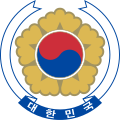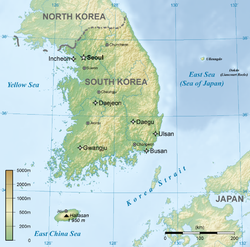

The following outline is provided as an overview of and topical guide to South Korea:
Contents
- General reference
- Geography of South Korea
- Environment of South Korea
- Regions of South Korea
- Demography of South Korea
- Government and politics of South Korea
- Branches of the government of South Korea
- Executive branch of South Korea
- Foreign relations of South Korea
- Law in South Korea
- Military of South Korea
- History of South Korea
- History of Korea
- Culture of South Korea
- Architecture of South Korea
- Art in South Korea
- Cuisine of South Korea
- Cultural icons of Korea
- Fashion in South Korea
- Holidays and festivals in South Korea
- Homes in South Korea
- People of South Korea
- Sport in South Korea
- Religion in South Korea
- Economy and infrastructure of South Korea
- Education in South Korea
- Health in South Korea
- Science and technology in South Korea
- See also
- References
- External links
South Korea – densely populated sovereign presidential republic located on the southern half of the Korean Peninsula in East Asia. [1] Also known as the "Land of the Morning Calm". It is neighbored by China to the west, Japan to the east and North Korea to the north. South Korea's capital and largest city is Seoul, the world's second largest metropolitan city.
Korea has a history of 5,000 years, [2] with its foundation dating back to 2333 BC by the legendary Dangun. Following the unification of the Three Korean Kingdoms under Silla in AD 668, Korea went through the Goryeo and Joseon Dynasty as one nation until annexed by Japan in 1910. [3] After Japan's defeat in World War II, Korea was divided, and South Korea was established in 1948. It has since developed a successful democracy, maintaining a strong alliance with the United States.
South Korea has the fourth-largest economy in Asia. It had one of the world's fastest growing economies from the 1960s until 1980 and is now considered a developed [4] economy. It is a G20 and OECD member. In response to tension with North Korea, it has developed the world's sixth largest armed forces and has one of the 10-largest defence budgets in the world.
South Korean industries have a strong focus on science and technology. [5] It has an advanced infrastructure [6] and information technology such as electronics, semiconductors, LCD displays, computers, mobile phones and automotive industry led by Chaebol, a kind of family-owned conglomerate. The economy also has a strong focus on engineering, construction, machinery, textiles, petrochemicals, biotechnology and robotics.















